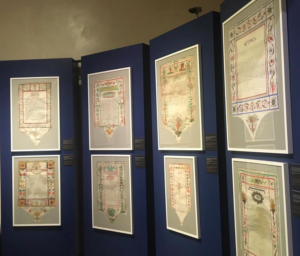CULTURE Rights and Responsibilities of Marriage: What the Roman Ketubot Tells Us
It was the first form of protection of women in Judaism, which gives a central role to the union between husband and wife (“It is not good that the man should be alone,” it says in Genesis). But it is also a different way, a more original perspective to look at the history of the Italian Jews and their complex spatio-temporal stories. It’s the ketubot, the marriage contracts stipulated on the occasion of the wedding, the subject of the exhibition “Concordia maritale” (“Marital harmony”), which opened at the Jewish Museum of Rome.
The exhibition has been put together thanks to the support of the Poste Italiane and curated by scholar Olga Melasecchi. It was also introduced by the chief rabbi rav Riccardo Di Segni, who explained the history and the characteristics of the various contracts that were used over the centuries (not only in Rome). The exhibition brings to the attention of the public an old collection of objects that provoked interest and emotion. There are also old photos of weddings, archival documents and prayer books.
Altogether, eighty-six marriage contracts handwritten on precious sheep parchment and decorated with water colors are kept at the museum and at the Community archive. Among the strong points of the exhibition, there are 11 family ketubot discovered and carefully studied by Celeste Pavoncello Piperno and Giovanna Grenga. For the museum, the donation of these ketubot “is evidence not only of the strong bond with tradition, but also of the trust in the museum, which has become the container of Jewish memory in Rome. The suggestive itinerary of the exhibition was presented to the public by the president of the Jewish community of Rome Ruth Dureghello and the CEO of Poste Italiane Matteo Del Fante. The Roman ketubah, a veritable form of art that peaked in the age of the ghetto, takes centre stage. An item of 1627, exceptionally lent by the Israel Museum of Jerusalem, stands out among the other pieces. In this ketubah, the marriage of one of the daughters of the family Toscano’s banker is celebrated. In the middle of the contract there’s an elegant portal supported by four columns with a golden menorah on the top. Further up, a picture of Jerusalem is represented.
Yesterday it was explained that the art of the ketubah reached its highest degree of refinement during the first half of the 18th century. The most commonly represented decorations are biblical scenes, allegorical figures and mythological scenes. These iconographic characteristics are typical of the Roman ketubah. Maybe they have little to do with the Jewish tradition, “but they were extremely widespread in Rome during the Baroque period, showing the ongoing osmosis between the ghetto and the rest of the city”.
The social value of the ketubot was very important at the time. Through them, in fact, families “not only demonstrated their status, but also very often celebrated exciting moments of freedom”. Many of the 86 contracts kept in Rome are decorated with the colours of the French flag, therefore they date back to the favorable period of the Napoleonic domination of Rome. Many others are decorated with the colors of the Italian flag and they date back to the period of the emancipation. In this period, with the Italian unification, but especially with the end of the temporal power of the popes and the final abolition of the ghetto, the Roman Jewish were finally considered equal to their fellow citizens. In order to better illustrate the luxury of the wedding ceremony, in the exhibition has also been set up a chuppah, the canopy that represents the cohabitation of the new couple, with the nuptial cloths and other dedicated ornaments.
Translation by Sara Volpe, student at the Advanced School for Interpreters and Translators of Trieste University, intern at the newspaper office of the Union of the Italian Jewish Communities.

